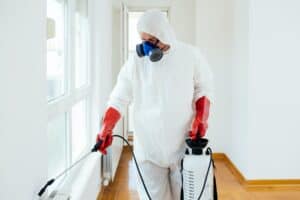
Termites are one of the most common household pests that can cause severe damage to your home. But suppose you know what to look for and how to treat a termite problem correctly. In that case, termite control will become much more doable.
In this article, we'll cover everything from how to prevent termite infestation to inspecting for termites and taking necessary measures for eradication.
Termites are one of the most destructive insects in your home. They can cause severe damage to your property, including structural damage, structural decay, and allergic reactions from dust mites. There are two types of termites, subterranean termites and dry wood termites. However, subterranean termites are considered more dangerous than the other variant. This is because they can cause more damage due to their saw-toothed jaws. 
Termites are not easy to detect because they hide in many places around your home. However, pest control experts can find them more easily than the residents.
There are many ways to prevent a termite infestation, but one of the most effective ways is to keep your home dry. Subterranean termites cannot live without moisture. You can also prevent an infestation by keeping trees, shrubs, and wood piles away from your house.
These pests love to thrive in damp, dark places. So, keep the gutters and pipes clean. This will prevent the chances of an infestation on your property. Also, you will have to be careful with mulch as subterranean termites like soil and certain types of mulch. Using mulch-containing materials like rubber or gravel is a better solution.
However, these techniques will not be helpful if you already have a termite infestation. In that case, you will have to focus on termite colony elimination.
If you suspect a termite infestation, here are a few ways to inspect it:
Hollow wood: If you suspect a termite infestation, knock or tap on your wood. An open sound means you have a termite infestation.
Mud tubes: Subterranean termites create mud tubes for their passageways. These are made using wood and soil. If you notice these small mud tubes, you have a subterranean termite infestation. However, the absence of mud tubes does not mean your home is free of termites, as dry wood termites do not make mud tubes.
Clicking sounds: If you hear a strange clicking sound inside your walls, the chances are that termites have infested your home. The clicking sound is caused when the soldier termites bang their heads against the wood to signal danger.
Scattered tiny wings: If you find many scattered attachments in or around your house, there is a chance of a termite infestation. Subterranean termites shed wings before creating a new colony.
Peeling paint: The peeling of stains can happen due to various reasons. However, if you notice it, along with the other signs above, you may have a termite infestation on your hands.
Frass: Frass means termite droppings. If you have a termite infestation, you will find small, granular, oval pellets or frass on your door frames and windowsills.
Termites are a huge problem in American homes, and their presence can cause much damage to your property. However, since termite colonies are hard to detect, you must know how to prevent them from coming into your home and infesting it.
You can treat termite colonies with pesticides or heat treatment. Pesticides are not as effective as heat treatment, and they may kill termites but will not be able to eradicate the colony. On the other hand, since you can extinguish all life stages within the colony (including eggs) with heat treatment, you can eliminate the infestation.
Although it may seem like a brilliant idea to treat the infestation without professional help, you should usually avoid doing so.In most cases, people without the proper knowledge and experience in termite control are usually not successful in exterminating the colony effectively. As a result, the home can get infested by termites again in the future.
To avoid such a situation in the future, hiring pest control companies like Green Solutions Lawn Care and Pest Control is highly recommended. Their experts are experienced in termite infestations throughout the Tampa Bay area. They will be able to assist you by eliminating the problem and providing preventative measures that will keep it from ever coming back again.
If there is already a termite infestation, the experts will use various techniques to deal with the situation. One of the most common ways to deal with a termite infestation is by spraying boric acid. Diatomaceous earth is also very effective in dealing with termites, and you have to sprinkle it in areas where you suspect a termite infestation. The experts use traps as well for dealing with a termite infestation. The experts can only decide the best course of action after visiting the site and inspecting the situation appropriately.
If a termite infestation is not found, the experts will install baits. These modern baits can easily stay active for nearly three years. Also, the appeal does not kill on contact. Rather, it acts as a slow poison and spreads around in the colony. Over time, the temptation prevents them from growing a new exoskeleton and eradicates the entire colony in three to four weeks. This will stop a subterranean termite infestation in your home. Moreover, Green Solutions Lawn Care and Pest Control experts will help eliminate dry wood termites with spot treatments.
Timely inspection is also provided to avoid any termite infestation issues in the future. Further, the experts will monitor the baits quarterly and replace them if they get water-logged or if more than 1/3 has been eaten.
If you suspect you have termites of either type, contact Green Solutions Lawn Care & Pest Control professionals today!
Already a Customer? Sign In Here